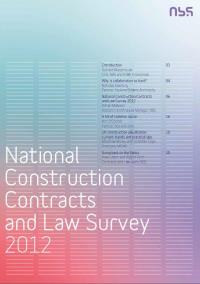From March to April 2012, we at NBS ran our first survey about contracts and legal issues within the UK construction industry. We ran the survey to understand, amongst other things:
 The different contracts and procurement methods being used
The different contracts and procurement methods being used - At what point in the process contracts are signed
- The number and kinds of disputes taking place
- How frequently partnering or collaborative working are used in construction projects.
To help the survey get industry wide representation more than 20 industry bodies, including the RIBA, assisted us by getting their members to take part. We received over 1,000 responses from across the industry. This cross industry participation has meant that, for the first time, the UK now has had a broad based, independent survey of these areas. The responses weren't just from architects and other consultants: clients and contractors took part too and the report breaks down responses by each group.
The findings give a full and at times startling picture of the UK construction industry's relationship with contract and law.
In some ways, the industry remains rather traditional. The future envisioned by Latham and Egan of high levels of collaboration, team integration and partnering have, at best, only been partially realized.
When we look at the contracts the industry uses, we see that traditional forms of contract still dominate. Sixty per cent of respondents tell us that the JCT Contracts are the ones they use most often, and 72 per cent of people used JCT Contracts at least once in the last year. That said, the NEC Contracts, associated more with non-traditional, collaborative working and procurement, have a firm place in the industry. Sixteen per cent tell us they use them most often and 29 per cent have used them at least once in the last year. For standard forms of contract, JCT and NEC dominate; together they are used more than all other standard contract types combined.
That said, "bespoke" contracts are widely used too; almost one quarter of respondents had used them in at least one project in the last year. Twenty years ago, the Latham Report concluded: "Endlessly refining existing conditions of contract will not solve adversarial problems. Public and private sector clients should begin to phase out bespoke documents". That "phasing out" is turning out to be a long process – but one we'll be able to track with subsequent surveys.
The adoption of electronic working also shows the traditional ways of working still remain. Whilst we continue to envisage an electronic future of BIM orientated, collaborative working, more than 40 per cent of consultants and clients are still not using electronic tendering at all. There's work to be done.
The report also gives an understanding of the number of disputes: both the perceived trend in the number of disputes in the industry and the number of disputes actually gone into by respondents. 92% of the respondents agreed that the number of disputes in the sectors had either increased or stayed at the same level, with the current state of the economy being most often described as the cause. This somewhat dark assessment is borne out by almost one quarter of those taking part in the survey having been involved in a dispute during 2011.
For us at NBS, and for the construction professionals we provide for, it's significant that 49 per cent of contractors who completed the survey tell us that "poor specification" is a "most difficult or recurrent issue" leading to dispute. Together, the issues people gave as the causes of dispute make clear the need for jointly owned, standardised information. A clear information model including tight specification and variance tracking can help prevent legal action later.
So, the overall picture that emerges is one of an industry that still makes use of traditional methods but which sees the place for more innovation. In many of the comments people made when completing the survey we could see a real desire for construction to be a collaborative, team-based enterprise where extra value is generated through cooperation. We hope to be moving towards a more collaborative industry. This move towards collaboration goes hand in hand with the move towards shared, co-owned information as well as in the choices of contracts and working methods.
One of the most, if not the most, significant impediments to true team working and collaboration is legal dispute whether actual, threatened or envisaged. The survey uncovered these disputes are disruptive, expensive and not uncommon. That's why from the outset, projects need standardized, shared information models that are easy to update, maintain and act upon. These need to clearly delineate where risk and responsibility lie. That's not to say the solution is just a technical one, or one of keeping records, though doing these things well can only help. Any information model, any discharge of a contract, can only be as successful as the team that creates and uses it.
We hope you enjoy reading the full report, and our thanks to everyone who completed the survey. We will be running it again in 2013 and hope you'll find the time to take part. It will be fascinating to see how the industry adapts to the many challenges and opportunities it faces.

